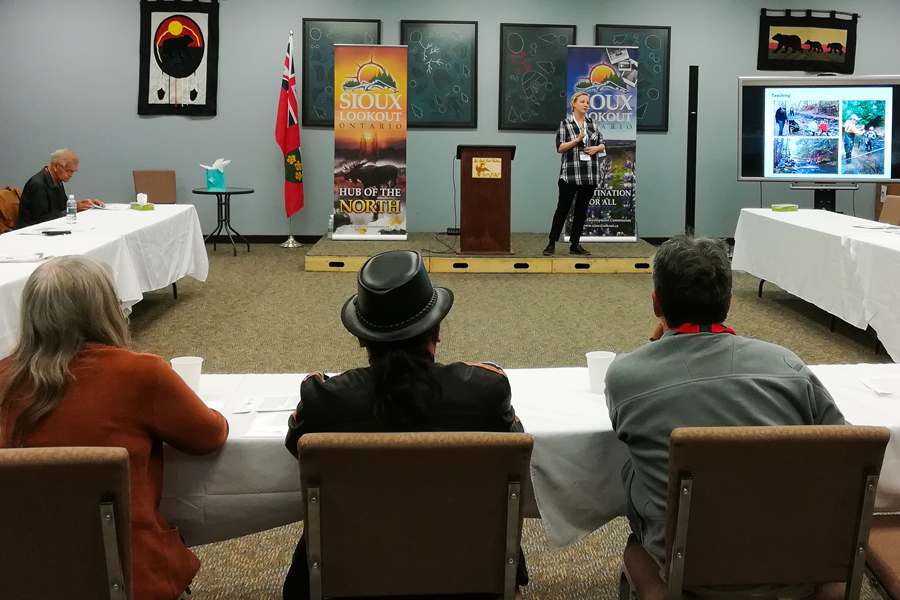Researchers at the Centre for Global Engineering (CGEN) are collaborating with Indigenous communities to address pressing infrastructure challenges facing geographically disparate communities across Canada.
CGEN’s Reconciliation Through Engineering Initiative (RTEI) will identify six projects that aim to improve access to clean drinking water, food security, housing, health care, transportation and communication systems from a multi-disciplinary and holistic perspective.
Since December, CGEN’s approach has been to first listen, learn and gather perspectives before defining any projects, says RTEI program lead Sonia Molodecky and research associate Shakya Sur.
“Our first step was to meet with Indigenous elders, youth, men and women to really understand — first and foremost — how we may approach a collaborative research relationship founded on respect and reciprocity,” says Molodecky. “We recognize that there are 10,000-plus years of knowledge and expertise that Indigenous Peoples have about their communities, relationships with the natural environment, and the interconnection and interdependence of all things. There is a lot we can learn. We are embarking on a co-learning journey.”
Two projects are in their early stages of development: one in northern Ontario and the high Arctic will focus on optimizing transportation routes to ensure timely delivery of food and supplies to communities. This work will have a multidisciplinary team of researchers, including professors Chris Beck (MIE), Chi-Guhn Lee (MIE), Shoshanna Saxe (CivMin), Tracey Galloway (Anthropology) and Michael Widener (Geography).
The second project will focus on developing a framework for designing building ventilation, envelope and integration of landscape-design features to mitigate mold, a significant concern for many Indigenous communities in Canada, says Sur.
“This work will lead to producing a set of housing guidelines that will inform the building of safer and healthier homes in the long term,” he says. “In addition to focusing on ventilation and building envelope design, the project will utilize landscape-design principles and an understanding of the relationship of the house to natural environment, to augment the overall performance of the house, as well as strengthen the residents’ connection to the land. Ultimately, this will contribute towards the long-term sustainability of the overall research outcomes.” This project will involve professors Marianne Touchie (CivMin), Bomani Khemet (Architecture) and Liat Margolis (Architecture).
On June 17 and 18, CGEN co-sponsored the First Annual Innovation Station Event in Lac Seul First Nation, where they met with Indigenous leaders representing 21 communities serviced by the Sioux Lookout area, in order to understand their needs and priorities and identify future partnerships. Among those present were former Chief Clifford Bull, Special Advisor on Indigenous affairs to the Ontario government, Doug Lawrance, Mayor of Sioux Lookout as well as a number of local industry and service providers.
Researchers in attendance included, professors Arthur Chan (ChemE), Jennifer Drake (CivMin), Jeffrey Siegel (CivMin), as well as Galloway and Bonnie McElhinny (Anthropology). Faculty members presented on their research expertise and learned about the communities’ challenges to better pinpoint potential areas for collaboration.
Also joining them was Elder Whabagoon, who stepped on the soil of her home community of Lac Seul First Nation for the first time since being taken away almost 59 years ago during the ‘Sixties Scoop’. Elder Whabagoon presented an initiative she co-created in partnership with University of Toronto Faculty of Architecture, Landscape, and Design (FALD) and First Nations House (FNH) and the Toronto Regional Conservation Authority (TRCA), called Nikibii Dawadinna Giigwag. This program works with Indigenous youth to re-connect their spirit with the land through the design of green infrastructure, architecture and land-based teachings.
“It was a very emotional experience coming home. My heart and feet felt grounded for the first time. My heart is full and I am so very grateful for the opportunity. I am very hopeful for the work going forward with my community and see real change being possible through this initiative” said Whabagoon.
Over the next twelve months, Molodecky and Sur will finalize the six research projects, secure further funding to support community participation, and host workshops at the university to give U of T Engineering students an opportunity to learn about the challenges facing Indigenous communities as well as the robust knowledge systems that they are using to address these challenges.
“We’re looking at the full picture. This is an opportunity for us to do things in a much more sustainable way, and the right way, thinking about many generations down the road,” says Sur. “The way to do that is to involve the youth — in our community and in Indigenous communities — so we can carry this effort forward, past the duration of the projects themselves.”




